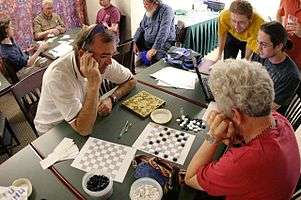Board game

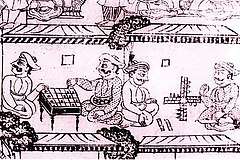
A board game is a tabletop game that involves counters or pieces moved or placed on a pre-marked surface or "board", according to a set of rules. Some games are based on pure strategy, but many contain an element of chance; and some are purely chance, with no element of skill.
Games usually have a goal that a player aims to achieve. Early board games represented a battle between two armies, and most modern board games are still based on defeating opponents in terms of counters, winning position, or accrual of points.
There are many varieties of board games. Their representation of real-life situations can range from having no inherent theme, like checkers, to having a specific theme and narrative, like Cluedo. Rules can range from the very simple, like Tic-tac-toe, to those describing a game universe in great detail, like Dungeons & Dragons – although most of the latter are role-playing games where the board is secondary to the game, serving to help visualize the game scenario.
The time required to learn to play or master a game varies greatly from game to game, but is not necessarily correlated with the number or complexity of rules; games like chess or Go possess relatively simple rulesets, but have great strategic depth.[1]
History
Ancient board games
Board games have been played in most cultures and societies throughout history. A number of important historical sites, artifacts, and documents shed light on early board games such as Jiroft civilization gameboards[2] in Iran. Senet, found in Predynastic and First Dynasty burials of Egypt, c. 3500 BC and 3100 BC respectively,[3] is the oldest board game known to have existed. Senet was pictured in a fresco found in Merknera's tomb (3300–2700 BC).[4][5] Also from predynastic Egypt is Mehen.
Backgammon originated in ancient Persia over 5,000 years ago. Chess, Pachisi and Chaupar originated in India. Go and Liubo originated in China. Shax originated in Somalia. Bao (mancala game) is still played throughout eastern Africa. Patolli originated in Mesoamerica played by the ancient Aztec and The Royal Game of Ur was found in the Royal Tombs of Ur, dating to Mesopotamia 4,600 years ago.[6] The earliest known games list is the Buddha games list.
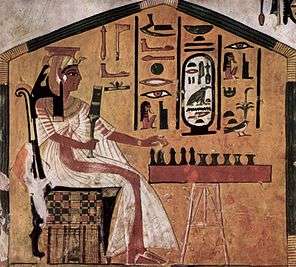 Senet, one of the oldest known board games |
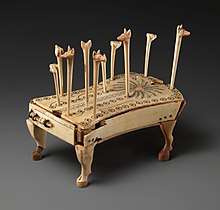 Hounds and Jackals (Egypt, 13th Dynasty) |
Europe
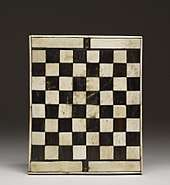 Box for Board Games, c. 15th century, Walters Art Museum |
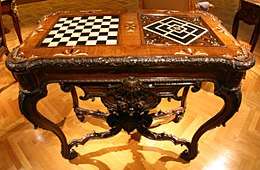 An early gaming table (Germany, 1735) featuring chess/draughts (left) and Nine Men's Morris (right), Cleveland Museum of Art |
United States
In 17th and 18th century colonial America, the agrarian life of the country left little time for game playing though draughts (checkers), bowling, and card games were not unknown. The Pilgrims and Puritans of New England frowned on game playing and viewed dice as instruments of the devil. When the Governor William Bradford discovered a group of non-Puritans playing stool-ball, pitching the bar, and pursuing other sports in the streets on Christmas Day, 1622, he confiscated their implements, reprimanded them, and told them their devotion for the day should be confined to their homes.
In Thoughts on Lotteries (1826) Thomas Jefferson wrote:
Almost all these pursuits of chance [i.e., of human industry] produce something useful to society. But there are some which produce nothing, and endanger the well-being of the individuals engaged in them or of others depending on them. Such are games with cards, dice, billiards, etc. And although the pursuit of them is a matter of natural right, yet society, perceiving the irresistible bent of some of its members to pursue them, and the ruin produced by them to the families depending on these individuals, consider it as a case of insanity, quoad hoc, step in to protect the family and the party himself, as in other cases of insanity, infancy, imbecility, etc., and suppress the pursuit altogether, and the natural right of following it. There are some other games of chance, useful on certain occasions, and injurious only when carried beyond their useful bounds. Such are insurances, lotteries, raffles, etc. These they do not suppress, but take their regulation under their own discretion.
The board game Traveller's Tour Through the United States and its sister game Traveller's Tour Through Europe were published by New York City bookseller F. & R. Lockwood in 1822 and today claims the distinction of being the first board game published in the United States.[6]
As the U.S. shifted from agrarian to urban living in the 19th century, greater leisure time and a rise in income became available to the middle class. The American home, once the center of economic production, became the locus of entertainment, enlightenment, and education under the supervision of mothers. Children were encouraged to play board games that developed literacy skills and provided moral instruction.[7]

The earliest board games published in the United States were based upon Christian morality. The Mansion of Happiness (1843), for example, sent players along a path of virtues and vices that led to the Mansion of Happiness (Heaven).[7] The Game of Pope and Pagan, or The Siege of the Stronghold of Satan by the Christian Army (1844) pitted an image on its board of a Hindu woman committing suttee against missionaries landing on a foreign shore. The missionaries are cast in white as "the symbol of innocence, temperance, and hope" while the pope and pagan are cast in black, the color of "gloom of error, and ... grief at the daily loss of empire".[8]
Commercially produced board games in the mid-19th century were monochrome prints laboriously hand-colored by teams of low-paid young factory women. Advances in paper making and printmaking during the period enabled the commercial production of relatively inexpensive board games. The most significant advance was the development of chromolithography, a technological achievement that made bold, richly colored images available at affordable prices. Games cost as little as US$.25 for a small boxed card game to $3.00 for more elaborate games.
American Protestants believed a virtuous life led to success, but the belief was challenged mid-century when the country embraced materialism and capitalism. In 1860, The Checkered Game of Life rewarded players for mundane activities such as attending college, marrying, and getting rich. Daily life rather than eternal life became the focus of board games. The game was the first to focus on secular virtues rather than religious virtues,[7] and sold 40,000 copies its first year.[9]
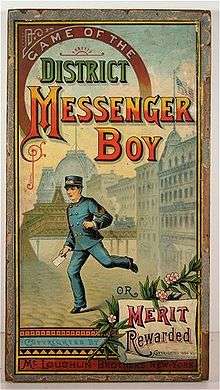
Game of the District Messenger Boy, or Merit Rewarded, published in 1886 by the New York City firm of McLoughlin Brothers, was one of the first board games based on materialism and capitalism published in the United States. The game is a typical roll-and-move track board game. Players move their tokens along the track at the spin of the arrow toward the goal at the track's end. Some spaces on the track will advance the player while others will send him back.
In the affluent 1880s, Americans witnessed the publication of Algeresque rags to riches games that permitted players to emulate the capitalist heroes of the age. One of the first such games, The Game of the District Messenger Boy, encouraged the idea that the lowliest messenger boy could ascend the corporate ladder to its topmost rung. Such games insinuated that the accumulation of wealth brought increased social status.[7] Competitive capitalistic games culminated in 1935 with Monopoly, the most commercially successful board game in U.S. history.[10]
McLoughlin Brothers published similar games based on the telegraph boy theme including Game of the Telegraph Boy, or Merit Rewarded (1888). Greg Downey notes in his essay, "Information Networks and Urban Spaces: The Case of the Telegraph Messenger Boy", that families who could afford the deluxe version of the game in its chromolithographed, wood-sided box would not "have sent their sons out for such a rough apprenticeship in the working world."[11]
Margaret Hofer described the period of 1880s–1920s as "The Golden Age" of board gaming in America.[6] Board game popularity was boosted, like that of many items, through mass production, which made them cheaper and more easily available.[12] Although there are no detailed statistics, some scholars suggest that the 20th century saw a decline in the popularity of the hobby.[12]
21st century

The late 1990s onwards have seen substantial growth in the reach and market of board games. This has been attributed to, among other factors, the Internet, which has made it easier for people to find out about games and to find opponents to play against.[12] Around the year 2000 the board gaming industry began significant growth with companies producing a rising number of new games to be sold to a growing worldwide audience.[13] In the 2010s, a number of publications referred to the board games as having a new Golden Age.[13][14] Board game venues are also growing in popularity; for example board game cafes are reported to be very popular in China.[15]
Luck, strategy, and diplomacy
Some games, such as chess, depend completely on player skill, while many children's games such as Candy Land and Snakes and Ladders require no decisions by the players and are decided purely by luck.[16]
Many games require some level of both skill and luck. A player may be hampered by bad luck in backgammon, Monopoly, Risk; but over many games a skilled player will win more often,[17] and the elements of luck can make for more excitement, and more diverse and multifaceted strategies, as concepts such as expected value and risk management must be considered.
Luck may be introduced into a game by a number of methods. The use of dice of various sorts goes back to the earliest board games. These can decide everything from how many steps a player moves their token, as in Monopoly, to how their forces fare in battle, as in Risk, or which resources a player gains, as in The Settlers of Catan. Other games such as Sorry! use a deck of special cards that, when shuffled, create randomness. Scrabble does something similar with randomly picked letters. Other games use spinners, timers of random length, or other sources of randomness. German-style board games are notable for often having less luck element than many North American board games.
Another important aspect of some games is diplomacy, that is, players making deals with one another. Negotiation generally features only in games with three or more players, cooperative games being the exception. An important facet of The Settlers of Catan, for example, is convincing players to trade with you rather than with opponents. In Risk, two or more players may team up against others. Easy diplomacy involves convincing other players that someone else is winning and should therefore be teamed up against. Advanced diplomacy (e.g., in the aptly named game Diplomacy) consists of making elaborate plans together, with the possibility of betrayal.[18]
In perfect information games, such as chess, each player has complete information on the state of the game, but in other games, such as Tigris and Euphrates or Stratego, some information is hidden from players. This makes finding the best move more difficult, and may involve estimating probabilities by the opponents.
Other media
Many board games are now available as video games, which can include the computer playing as one or more opponents. Many board games can now be played online against a computer and/or other players. Some websites allow play in real time and immediately show the opponents' moves, while others use email to notify the players after each move.[19] The Internet and cheaper home printing has also influenced board games via print-and-play games that may be purchased and printed.[20] Some games use external media such as audio cassettes or DVDs in accompaniment to the game.[21][22]
There are also virtual tabletop programs that allow online players to play a variety of existing and new board games through tools needed to manipulate the game board, but do not necessarily enforce the game's rules, leaving this up to the players. There are generalized programs such as Vassal, Tabletop Simulator and Tabletopia that can be used to play any board or card game, while programs like Roll20 and Fantasy Grounds that are more specialized for role-playing games.[23][24] Some of these virtual tabletops have worked with the license holders to allow for use of their game's assets within the program; for example, Fantasy Grounds has licenses for both Dungeons & Dragons and Pathfinder materials, while Tabletop Simulator has allows game published to provide paid downloadable content for their games.[25][26] However, as these games offer the ability to add in content through user modifications, there are also unlicensed uses of board game assets available through these programs.[27]
Market

While the board gaming market is estimated to be smaller than that for video games, it has also experienced significant growth from the late 1990s.[14] A 2012 article in The Guardian described board games as "making a comeback".[28] Another from 2014 gave an estimate that put the growth of the board game market at "between 25% and 40% annually" since 2010, and described the current time as the "golden era for board games".[14] The rise in board game popularity has been attributed to quality improvement (more elegant mechanics, components, artwork, and graphics) as well as increased availability thanks to sales through the Internet.[14]
A 1991 estimate for the global board game market was over $1.2 billion.[29] A 2001 estimate for the United States "board games and puzzle" market gave a value of under $400 million, and for United Kingdom, of about £50 million.[30] A 2009 estimate for the Korean market was put at 800 million won,[31] and another estimate for the American board game market for the same year was at about $800 million.[32] A 2011 estimate for the Chinese board game market was at over 10 billion yuan.[33] (Some estimates may split board games from collectible card, miniature and role-playing games; for example another 2014 estimate distinguishing board games from other types of hobby games gave the estimate for the U.S. and Canada market at only $75 million, with the total size of what it defined as the hobby game market at over $700 million,[34] with a 2015 estimate suggesting a value of almost $900 million[35]) A 2013 estimate put the size of the German toy market at 2.7 billion euros (out of which, the board games and puzzle market is worth about 375 million euros), and Polish markets, at 2 billion and 280 million złoties, respectively.[36] Per capita, in 2009 Germany was considered to be the best market, with the highest number of games sold per individual.[37]
Research into gaming
A dedicated field of research into gaming exists, known as game studies or ludology.
While there has been a fair amount of scientific research on the psychology of older board games (e.g., chess, Go, mancala), less has been done on contemporary board games such as Monopoly, Scrabble, and Risk.[38] Much research has been carried out on chess, in part because many tournament players are publicly ranked in national and international lists, which makes it possible to compare their levels of expertise. The works of Adriaan de Groot, William Chase, Herbert A. Simon, and Fernand Gobet have established that knowledge, more than the ability to anticipate moves, plays an essential role in chess-playing.[39]
Linearly arranged board games have been shown to improve children's spatial numerical understanding. This is because the game is similar to a number line in that they promote a linear understanding of numbers rather than the innate logarithmic one.[40]
Research studies show that board games such as Snakes and Ladders result in children showing significant improvements in aspects of basic number skills such as counting, recognizing numbers, numerical estimation and number comprehension. They also practice fine motor skills each time they grasp a game piece.[41] Playing board games has also been tied to improving children's executive functions.[42] Related to this is a growing academic interest in the topic of game accessibility, culminating in the development of guidelines for assessing the accessibility of modern tabletop games[43] and the extent to which they are playable for people with disabilities.[44]
Additionally, board games can be therapeutic. Bruce Halpenny, a games inventor said when interviewed about his game, The Great Train Robbery:
With crime you deal with every basic human emotion and also have enough elements to combine action with melodrama. The player's imagination is fired as they plan to rob the train. Because of the gamble they take in the early stage of the game there is a build-up of tension, which is immediately released once the train is robbed. Release of tension is therapeutic and useful in our society, because most jobs are boring and repetitive.[45]
Playing games has been suggested as a viable addition to traditional educational curriculum.[46]
Categories
There are a number of ways in which board games can be classified,[6] and considerable overlap may exist, so that a game belong in several categories.[6] The following is a list of some of the most common:
- Abstract strategy games – e.g. chess, checkers, Go, Reversi, tafl games, or modern games such as Abalone, Halma, Stratego, Hive, or GIPF
- Alignment games – e.g. Renju, Gomoku, Connect6, Nine Men's Morris, or Tic-tac-toe
- Auction games – e.g. Hoity Toity
- Chess variants – traditional variants e.g. shogi, xiangqi, or janggi; modern variants e.g. Chess960, Grand Chess, Hexagonal chess, or Alice Chess
- Configuration games – e.g. Lines of Action, Hexade, or Entropy
- Connection games – e.g. TwixT, Hex, or Havannah
- Cooperative games – e.g. Max the Cat, Caves and Claws, or Pandemic
- Count and capture games – e.g. mancala games
- Cross and circle games – e.g. Yut, Ludo, or Aggravation
- Deduction games – e.g. Mastermind or Black Box
- Dexterity games – e.g. Tumblin' Dice or Pitch Car
- Economic simulation games – e.g. The Business Game, Monopoly, or The Game of Life
- Educational games – e.g. Arthur Saves the Planet, Cleopatra and the Society of Architects, or Shakespeare: The Bard Game
- Elimination games – e.g. draughts, Alquerque, Fanorona, Yoté, or Surakarta
- Family games – e.g. Roll Through the Ages, Birds on a Wire, or For Sale
- Fantasy games – e.g. Shadows Over Camelot
- German-style board games or Eurogames – e.g. The Settlers of Catan, Carcassonne, Decatur • The Game, Carson City, or Puerto Rico
- Guessing games – e.g. Pictionary or Battleship
- Hidden-movement games – e.g. Clue or Escape from the Aliens in Outer Space
- Hidden-role games – e.g. Mafia or The Resistance
- Historical simulation games – e.g. Through the Ages or Railways of the World
- Large multiplayer games – e.g. Take It Easy or Swat (2010)
- Learning/communication non-competitive games – e.g. The Ungame (1972)
- Mancala games – e.g. Wari, Oware, or The Glass Bead Game
- Multiplayer games – e.g. Risk, Monopoly, or Four-player chess
- Musical games – e.g. Spontuneous
- Negotiation games – e.g. Diplomacy
- Paper-and-pencil games – e.g. Tic-tac-toe or Dots and Boxes
- Physical skill games – e.g. Camp Granada
- Position games (no captures; win by leaving the opponent unable to move) – e.g. Konane, mū tōrere, or the L game
- Race games – e.g. Pachisi, backgammon, Snakes and Ladders, Hyena chase, or Worm Up
- Role-playing games – e.g. Dungeons & Dragons
- Roll-and-move games – e.g. Monopoly or Life
- Running-fight games – e.g. Bul
- Share-buying games (games in which players buy stakes in each other's positions) – typically longer economic-management games, e.g. Acquire or Panamax
- Single-player puzzle games – e.g. peg solitaire or Sudoku
- Spiritual development games (games with no winners or losers) – e.g. Transformation Game or Psyche's Key
- Storytelling games – e.g. Dixit or Tales of the Arabian Nights
- Stacking games – e.g. Lasca or DVONN
- Territory games – e.g. Go or Reversi
- Tile-based games – e.g. Carcassonne, Scrabble, Tigris and Euphrates, or Evo
- Train games – e.g. Ticket to Ride, Steam, or 18xx
- Trivia games – e.g. Trivial Pursuit
- Two-player-only themed games – e.g. En Garde or Dos de Mayo
- Unequal forces (or "hunt") games – e.g. Fox and Geese or Tablut
- Wargames – ranging from Risk, Diplomacy, or Axis & Allies, to Attack! or Conquest of the Empire
- Word games – e.g. Scrabble, Boggle, Anagrams, or What's My Word? (2010)
Glossary
Although many board games have a jargon all their own, there is a generalized terminology to describe concepts applicable to basic game mechanics and attributes common to nearly all board games.
See also
- BoardGameGeek—a board game community and website database
- Going Cardboard—a documentary, including interviews with game designers and game publishers
- History of games
- Interactive movie—DVD games
- List of board games
- List of game manufacturers
- Mind sport
- Snakes and Lattes—a board game café
References
- ↑ "Chess itself is a simple game to learn but its resulting strategy is profound." Pritchard, D.B. (1994). The Encyclopedia of Chess Variants. Games & Puzzles Publications. p. 84. ISBN 0-9524142-0-1.
- ↑ Madjidzadeh, Y (2003) Jiroft, The earliest oriental civilization. Organization of the Ministry of Culture and Islamic Guidance, Tehran
- ↑ Piccione, Peter A. (July–August 1980). "In Search of the Meaning of Senet" (PDF). Archaeology: 55–58. Retrieved 2018-07-14.
- ↑ "Okno do svita deskovych her". Hrejsi.cz. 1998-04-27. Archived from the original on 8 December 2012. Retrieved 2010-02-12.
- ↑ Pivotto, Carlos; et al. "Detection of Negotiation Profile and Guidance to more Collaborative Approaches through Negotiation Games" (PDF). Retrieved 2014-10-02.
- 1 2 3 4 5 Jason R. Edwards, Saving Families, One Game at a Time
- 1 2 3 4 Jensen, Jennifer (2003). "Teaching Success Through Play: American Board and Table Games, 1840-1900". Magazine Antiques. bnet. Retrieved 2009-02-07.
- ↑ Fessenden, Tracy (2007). Culture and Redemption: Religion, the Secular, and American Literature. Princeton University Press. p. 271. Retrieved 2009-02-07.
- ↑ Hofer, Margaret K. (2003). The Games We Played: The Golden Age of Board & Table Games. Princeton Architectural Press. Retrieved 2009-02-07.
- ↑ Weber, Susan & Susie McGee (n.d.). "History of the Game Monopoly". Archived from the original on 10 February 2009. Retrieved 2009-02-03.
- ↑ Downey, Greg (November 1999). "Information Networks and Urban Spaces: The Case of the Telegraph Messenger Boy". Antenna. Mercurians. Archived from the original on 7 August 2008. Retrieved 2009-02-07.
- 1 2 3 Damian Gareth Walker (5 November 2014). A Book of Historic Board Games. Lulu.com. p. 13. ISBN 978-1-326-03480-1.
- 1 2 Smith, Quintin (October 2012). "The Board Game Golden Age". Archived from the original on 1 June 2013. Retrieved 2013-05-10.
- 1 2 3 4 Duffy, Owen. "Board games' golden age: sociable, brilliant and driven by the internet". the Guardian.
- ↑ "Six Reasons China Loves Board Game Cafés". Flamingo. Archived from the original on 20 May 2016. Retrieved 22 April 2016.
- ↑ "The case against Candy Land", Jan 26, 2009, BoingBoing.com
- ↑ "Luck vs. Skill in Backgammon"
- ↑ "Lying and Cheating by the Rules" Joseph McLellan, June 2, 1986, The Washington Post
- ↑ "U3a International Chess by Email". Retrieved 2014-10-08.
- ↑ "Print & Play". Retrieved 2014-10-08.
- ↑ "DVD Board Games". Retrieved 2014-10-08.
- ↑ "Audio Cassette Board Games". Retrieved 2014-10-08.
- ↑ Hall, Charlie (22 April 2015). "D&D now on Steam, complete with dice and a Dungeon Master". Polygon. Retrieved 10 April 2017.
- ↑ Hall, Charlie (December 1, 2016). "Tabletopia is slick as hell, and it's free on Steam". Polygon. Retrieved September 7, 2017.
- ↑ "SmiteWorks USA, LLC". Fantasy Grounds. SmiteWorks. Retrieved 21 July 2017.
- ↑ O'Conner, Alice (October 1, 2015). "Cosmic Encounter Officially Invades Tabletop Simulator". Rock Paper Shotgun. Retrieved August 1, 2016.
- ↑ Wawro, Alex (July 3, 2015). "Mod Mentality: How Tabletop Simulator was made to be broken". Gamasutra. Retrieved July 8, 2015.
- ↑ Freeman, Will. "Why board games are making a comeback". the Guardian.
- ↑ Scanlon, Jennifer (2001). "Board games". In Browne, Ray Broadus; Browne, Pat. The Guide to United States Popular Culture. Popular Press. p. 103. ISBN 978-0-87972-821-2.
- ↑ "So you've invented a board game. Now what?".
- ↑ "Educational Games Getting Popular". The Korea Times. 22 July 2009. Archived from the original on 5 January 2016.
- ↑ "Monopoly, Candy Land May Offer Refuge to Families in Recession". Archived from the original on 26 November 2014.
- ↑ "Chinese Board Game Market Overview - LP Board Game". LP Board Game. Archived from the original on 21 February 2016.
- ↑ "Hobby Games Market Hits $700M". ICv2.
- ↑ "HOBBY GAMES MARKET CLIMBS TO $880 MILLION". ICv2.
- ↑ "Pamiętacie Eurobiznes? Oto wielki powrót gier planszowych, dla których oni zarywają noce". Menstream.pl. 2013-04-16. Archived from the original on 5 January 2016.
- ↑ "Monopoly Killer: Perfect German Board Game Redefines Genre". WIRED. Archived from the original on 10 May 2015. Retrieved 23 April 2015.
- ↑ Gobet, Fernand; de Voogt, Alex; Retschitzki, Jean (2004). Moves in mind: The psychology of board games. Psychology Press. ISBN 1-84169-336-7.
- ↑ Simons, Daniel (February 15, 2012). "How experts recall chess positions". The Invisible Gorilla. Retrieved 21 November 2017.
- ↑ "Playing Linear Number Board Games—But Not Circular Ones—Improves Low-Income Preschoolers' Numerical Understanding" (PDF).
- ↑ LeFebvre, J.E. "Parenting the preschooler" (PDF). UW Extension. Archived from the original (PDF) on 21 May 2014. Retrieved 10 March 2015.
- ↑ "How Family Game Night Makes Kids Into Better Students". Retrieved 23 April 2015.
- ↑ Heron, Michael James; Belford, Pauline Helen; Reid, Hayley; Crabb, Michael (2018-04-27). "Meeple Centred Design: A Heuristic Toolkit for Evaluating the Accessibility of Tabletop Games". The Computer Games Journal: 1–18. doi:10.1007/s40869-018-0057-8. ISSN 2052-773X.
- ↑ Heron, Michael James; Belford, Pauline Helen; Reid, Hayley; Crabb, Michael (2018-04-21). "Eighteen Months of Meeple Like Us: An Exploration into the State of Board Game Accessibility". The Computer Games Journal: 1–21. doi:10.1007/s40869-018-0056-9. ISSN 2052-773X.
- ↑ Stealing the show. Toy Retailing News, Volume 2 Number 4 (December 1976), p. 2
- ↑ Harris, Christopher (n.d.). "Meet the New School Board: Board Games Are Back--And They're Exactly What Your Curriculum Needs". School Library Journal. 55 (5): 24–26. ISSN 0362-8930. Retrieved 23 April 2015.
Further reading
- Austin, Roland G. "Greek Board Games." Antiquity 14. September 1940: 257–271
- Bell, R. C. (1983). The Boardgame Book. Exeter Books. ISBN 0-671-06030-9.
- Bell, R. C. (1979) [1st Pub. 1960, Oxford University Press, London]. Board and Table Games From Many Civilizations. I (Revised ed.). Dover Publications Inc. ISBN 0-671-06030-9.
- Bell, R. C. (1979) [1st Pub. 1969, Oxford University Press, London]. Board and Table Games From Many Civilizations. II (Revised ed.). Dover Publications Inc. ISBN 0-671-06030-9.
- Diagram Group (1975). Midgley, Ruth, ed. The Way to Play. Paddington Press Ltd. ISBN 0-8467-0060-3.
- Falkener, Edward (1961) [1892]. Games Ancient and Oriental and How to Play Them. Dover Publications Inc. ISBN 0-486-20739-0.
- Fiske, Willard. Chess in Iceland and in Icelandic Literature—with historical notes on other table-games. Florentine Typographical Society, 1905.
- Gobet, Fernand; de Voogt, Alex & Retschitzki, Jean (2004). Moves in mind: The psychology of board games. Psychology Press. ISBN 1-84169-336-7.
- Golladay, Sonja Musser, "Los Libros de Acedrex Dados E Tablas: Historical, Artistic and Metaphysical Dimensions of Alfonso X’s Book of Games" (PhD diss., University of Arizona, 2007)
- Gordon, Stewart (July–August 2009). "The Game of Kings". Saudi Aramco World. Houston: Aramco Services Company. 60 (4): 18–23. Archived from the original on 2009-07-20. (PDF version)
- Grunfeld, Frederic V. (1975). Games of the World. Holt, Rinehart and Winston. ISBN 0-03-015261-5.
- Mohr, Merilyn Simonds (1997). The New Games Treasury. Houghton Mifflin Company. ISBN 1-57630-058-7.
- Murray, H. J. R. (1913). A History of Chess (Reissued ed.). Oxford University Press. ISBN 0-19-827403-3.
- Murray, H. J. R. (1978). A History of Board-Games other than Chess (Reissued ed.). Hacker Art Books Inc. ISBN 0-87817-211-4.
- Parlett, David (1999). The Oxford History of Board Games. Oxford University Press Inc. ISBN 0-19-212998-8.
- Pritchard, D. B. (1982). Brain Games. Penguin Books Ltd. ISBN 0-14-00-5682-3.
- Pritchard, David (1994). The Family Book of Games. Brockhampton Press. ISBN 1-86019-021-9.
- Rollefson, Gary O., "A Neolithic Game Board from Ain Ghazal, Jordan", Bulletin of the American Schools of Oriental Research, No. 286. (May 1992), pp. 1–5.
- Sackson, Sid (1983) [1st Pub. 1969, Random House, New York]. A Gamut of Games. Arrow Books. ISBN 0-09-153340-6.
- Schmittberger, R. Wayne (1992). New Rules for Classic Games. John Wiley & Sons Inc. ISBN 978-0471536215.
- Reprint: Random House Value Publishing, 1994. ISBN 0-517-12955-8
External links
| Wikimedia Commons has media related to Board games. |
- International Board Game Studies Association
- Board Games at Curlie (based on DMOZ)
- BoardGameGeek
